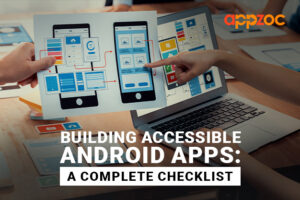
Flutter
Make the most of this cutting-edge technology by developing apps quickly! Our Flutter solutions have amazing features that can be used to create sleek, high-performance apps that can scale seamlessly across platforms.

In today’s digital world, creating accessible Android apps isn’t just a good practice; it’s a legal requirement. Accessibility ensures that your app can be used by individuals with disabilities, opening your app to a broader user base and potentially increasing your user engagement and revenue. Whether you’re an Android app development company in Bangalore or Android app developers in Kerala, building accessible apps is a must. In this comprehensive guide, brought to you by Appzoc Technologies, we’ll explore the essential checklist for creating Android apps that are inclusive and accessible to everyone.
Before we dive into the checklist, let’s understand why accessibility is critical for Android app development.
Many countries, including the United States, have laws like the Americans with Disabilities Act (ADA) and the Web Content Accessibility Guidelines (WCAG), which require digital content, including mobile apps, to be accessible to individuals with disabilities.
Making your app accessible opens it up to a wider audience. There are over a billion people worldwide with disabilities, and by making your app accessible, you tap into this vast market.
Accessibility features not only benefit users with disabilities but also enhance the overall user experience.Well-designed accessible apps are often more user-friendly and intuitive.
Companies that prioritize accessibility demonstrate their commitment to diversity and inclusivity, building a positive brand image.
Now, let’s explore the checklist to ensure your Android app is accessible to all users:
Start by familiarizing yourself with the accessibility guidelines specific to Android apps. Google’s Accessibility Developer Guide is a valuable resource to get you started.
All photos should have meaningful alternative text (alt text). This is critical for screen reader users who rely on the content to be understood.
Ensure your app’s color scheme is accessible to individuals with color blindness. Use tools to check color contrast ratios and choose color combinations that meet accessibility standards.
Make sure users can navigate your app using a keyboard or keyboard emulator. Ensure that all interactive elements are reachable and usable via keyboard input.
Test your app with screen readers like VoiceOver (iOS) and TalkBack (Android) to ensure proper compatibility and usability.
Allow users to adjust text size within the app. Choose legible fonts and maintain a consistent font size throughout the app.
Use appropriate HTML elements like headings, lists, and semantic markup to structure content. This helps screen readers interpret the content correctly.
Include closed captions for multimedia content like videos.This benefits users who are deaf or hard of hearing.
Ensure that there are clear visual indicators of focus on interactive elements when navigating with a keyboard or screen reader.
Regularly test your app using accessibility testing tools and accessibility services provided by Android. Correct any issues that are identified during testing.
Implement voice command functionality, allowing users to navigate and interact with your app using voice commands.
Make touch targets and gestures user-friendly. Ensure they are large enough and well-spaced to prevent accidental taps and accommodate users with motor disabilities.
Provide Tactile Feedback
Incorporate tactile feedback, such as vibrations, for important app interactions. This helps users with visual impairments and can enhance the user experience for all.
Ensure that error messages are clear, concise, and provide guidance on how to resolve issues. Avoid relying solely on color to indicate errors.
Use descriptive labels for form fields and interactive elements.This helps users understand the purpose of each element.
Engage users with disabilities for testing and gather feedback to identify areas of improvement. Their insights can be invaluable in making your app more accessible.
Accessibility standards and technologies evolve. Stay updated with the latest guidelines and continuously improve your app’s accessibility.
Appzoc Technologies: Your Accessibility-Driven Android App Development Partner Whether you are an Android app development company in Bangalore or Android app developers in Kerala, prioritizing accessibility in your app development process is paramount. At Appzoc Technologies, we understand the importance of creating inclusive and accessible mobile apps. Our team of expert developers is well-versed in accessibility guidelines and is committed to delivering apps that cater to diverse user needs.
Incorporating accessibility features in your Android app not only ensures legal compliance but also demonstrates your commitment to a user-centric approach. It’s a step towards making your app a valuable resource for everyone, regardless of their abilities.
Are you ready to create an Android app that sets new standards for accessibility? Contact Appzoc Technologies today, and let’s embark on a journey to build inclusive mobile experiences for all.
Accessibility is no longer an option; it’s a requirement for Android app development. Whether you are an Android app development company in Bangalore or Android app developers in Kerala, following this accessibility checklist will help you create apps that are not only compliant with legal standards but also inclusive and user-friendly. By making your app accessible to all, you open up new opportunities and ensure that your app can be enjoyed by a broader audience, ultimately leading to greater success in the competitive app market.